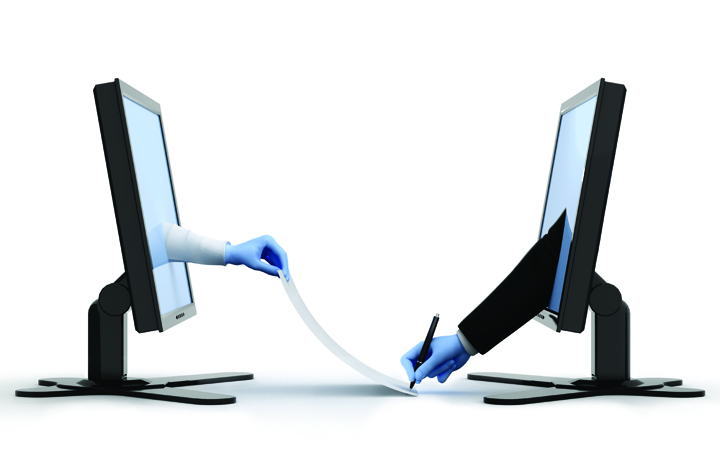 |
 |
 |
Technology e-Signature technology The "e" stands for efficient, economical, easy ... oh, and electronic
By Nancy Doucette Last month's article, "Signing on the electronic dotted line" provided a 20,000-foot look at electronic signatures and discussed how the Agents Council for Technology (ACT), ACORD and AUGIE are spreading the word on the benefits of this technology with free how-to/best practices guidelines, webinars, and roadshows. This month we hear from agents on how they have implemented e-signature technology to improve cycle times and the customer experience. It's late in the day on Friday. A producer has brought in the E&S application for a new account and wants it processed before close of business. But wait … he forgot to get the surplus lines affidavit signed by the insured and the E&S broker can't bind coverage without it. Time to push the panic button? Not at Jones & Wenner Insurance Agency in Fairlawn, Ohio. Thanks to their implementation of e-signature technology in late summer 2012, the omitted form was e-mailed to the insured who received it on her smartphone, signed it, and returned it in under five minutes.
According to Joyce Sigler, CISR, CPIW, CPIA, NcAM, vice president of Jones & Wenner, "All the insured did was tap the two designated areas of the document on the screen of her smartphone. This is truly once and done." She notes that the agency has a niche in trucking and transportation and writes business across seven states. "We rarely see our customers. But with e-signature technology, we can close an account in one day rather than a week." Sigler recalls that she was first introduced to e-signature technology at a Network of Vertafore Users (NetVU) PowerUsers conference in the fall of 2011. Panelists discussed seven different e-signature products—features, pricing, security, whether there was a free trial, support, document attachment capabilities, and what e-mail products it supported. Her interest was piqued. She began monitoring e-signature technology on Forrester Waves™ which offers market overview reports as well as suggestions for what to look for in an e-signature provider—company stability, professional services, a customizable solution, electronic evidence, online session management, and mobile support, for example. ACORD released its "Guidelines for e-Signature and e-Delivery in the Insurance Business"—an overview of the legal requirements and best practices for implementation developed specifically for the insurance industry by international law firm Locke Lord, LLP. Based on the Guidelines, Jones & Wenner reviewed its carrier contracts and determined there was no reason not to employ e-signatures. To assist with the product selection process, the agency created its own eight-point checklist (above) which was based on information from Forrester Waves and ACORD. DocuSign met all the requirements. "They have an insurance division so they know our business," Sigler says. "Electronic signatures aren't just a product for them; that's all they do." Additionally, she says, she was confident that a DocuSigned document would stand up in court. The agency decided that using e-signatures was a service process, not a sales process so Jones & Wenner obtained DocuSign licenses for its service staff only. Once an account is sold, the producer explains to the client that they will be receiving an e-mail with the necessary paperwork attached which requires their signature and that it will take only a couple of clicks to complete it. Clients have been overwhelmingly receptive. "About 2% of the documents we send out that require signatures go via surface mail," Sigler reports. "If you're able to pull up a document on your device, you're able to complete an e-signature transaction," she says. "Once I send the document to the DocuSign cloud, the program automatically sends it to all the parties we need signatures from," Sigler explains. "The program tells me who has opened the packet and whether that person has signed it. If the recipient delays opening the packet, DocuSign automatically sends a reminder. If the packet isn't opened within a prescribed timeframe, it times out and we receive a message that the packet has expired." Once the transaction is complete, DocuSign sends a PDF of all the signed documents back to the agency where they are dragged and dropped into the management system and sent on to carriers. Sigler says using e-signature technology has made incomplete documents a thing of the past because the program won't let a signer close a document until all boxes requiring initials, signatures and/or dates are checked. As e-signature technology has gained traction in the insurance industry, some carriers are offering their own e-signature capabilities at their Web sites and provide policy credits for using it, Sigler says. The agency has worked with those carriers so that they accept the DocuSigned transactions and still provide the credits. Bigger picture, as ACT Executive Director Jeff Yates noted in last month's article, carriers would better serve their agent partners by offering e-signature guidelines, rather
than implementing their own solutions. Improved customer experience Donna Hamilton, CIC, CISR, operations manager at Byrnes Agency in Dayville, Connecticut, says the agency was an early adopter of e-signature technology, thanks in part to agency Principal Jay Byrnes' participation in ACT, the Big "I" and the Nexsure User Group. "He's great about looking for ways for us to do our jobs easier, quicker, and more efficiently," Hamilton states. With 25 users, the agency has been using Adobe EchoSign for about two years. In the case of e-signature technology, though, the initial interest was to improve the customer's experience. "People are busy," Hamilton observes. "They can't always stop by to sign whatever it is we need a signature on." While the account managers are the heaviest users of this technology, she says one of the agency's producers has EchoSign on his iPad. It comes in handy when he's visiting a client's place of business. "He has various applications that are on EchoSign," she explains. "He can fill in the application while he's with the client and set it up for in-person signing. He hands the iPad over to the client, the keypad appears, and the client e-signs." When the producer returns to the office, the application is moved into the agency's Nexsure management system and forwarded on to the carrier … all without generating a single sheet of paper. Hamilton says she pulled PDFs of blank ACORD forms as well as company-specific forms—wood stove questionnaires and medical statements for older drivers, for instance—into EchoSign to build the forms library. "Once the initial load is complete, it's just a matter of updating forms as new ones become available," she says. She says the agency offers clients options on how they wish to receive documents for signature: They can come in and sign or they can EchoSign. "I can't think of an instance where a client has declined the e-signature option," she says. "They appreciate that they can do it anytime, anywhere." That's especially true when a client discovers their policy has lapsed. Hamilton says the agency can usually get the policy reinstated with a credit card payment but the carrier wants a signed "no loss" form as well ... and they want it immediately. "We EchoSign the client the 'no loss' form, they sign it and get it right back to us. They're covered immediately," she says.
Logical workflow For Seely & Durland Insurance, in Warwick, New York, e-signature technology "is still pretty young," says Stu Durland, AAI, AINS, vice president. Durland explains that the agency started using RPost's registered e-mail delivery proof and encryption for data privacy compliance services in 2004 when he was chair of the Applied Systems Client Network (ASCnet). So when RPost began offering e-signature services, Seely & Durland was onboard. The same couldn't be said for the carriers the agency represented, though. Durland says less than a year ago, he was getting "mixed signals" from carriers when he asked whether they would accept e-signatures, and that slowed the agency's adoption of e-signature capabilities. As of mid-September 2013, he says "most carriers are seeing that e-signatures are acceptable; they're seeing that the workflow makes all the sense in the world." He credits the work of ACT, AUGIE, and ACORD for getting that message out. With most agencies being paperless, it doesn't make sense to print a document in order to have the insured place a "wet signature" on it. That document then has to be scanned back into the agency management system and the document is shredded. Being able to keep a transaction totally electronic is much more efficient, Durland says. He continues: "E-signature technology isn't free but agents need to take into account the time savings—quicker turnaround on getting documents signed and processed; there is also less follow-up, less postage, less toner, less paper. Those expenditures do nothing to enhance the client experience. Spending less time chasing paper and following up gives staff more time to do other things … like cross-sell. It gets back to the reasons for doing real time. "Your customers are going to be happy as well," Durland concludes. "You've provided something in an advanced format, rather than the old-fashioned way, and that leaves a positive impression." For more information: Adobe EchoSign DocuSign RPost
|
|||||||||||
| |||||||||||
| ©The Rough Notes Company. No part of this publication may be reproduced, translated, stored in a database or retrieval system, or transmitted in any form by electronic, mechanical, photocopying, recording, or by other means, except as expressly permitted by the publisher. For permission contact Samuel W. Berman. |



